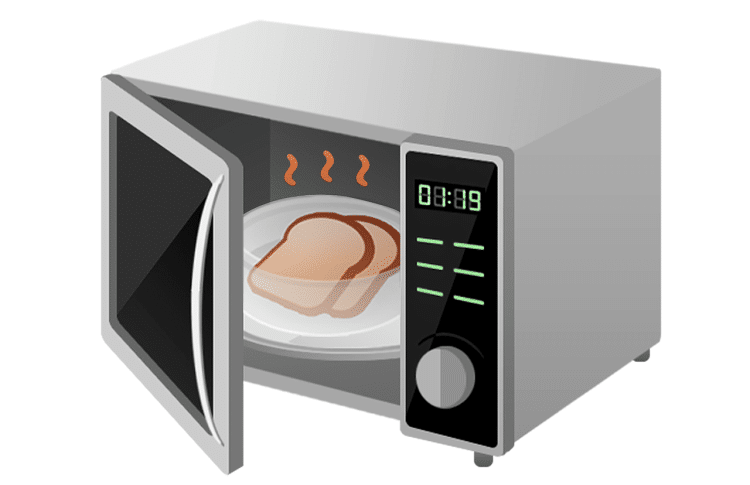These days, just about everything can be microwaved. Cannabis extractors are even turning to microwaves to improve efficiency and reduce costs. But how does microwave-assisted extraction work? And also of import, can I use a household microwave oven for cannabis extraction?
First, the fundamentals: microwaves are electromagnetic waves/radiation with frequencies falling in the range of 0.3–300 gigahertz (GHz). [1] For reference, household microwave ovens usually operate at 2.45 GHz as this frequency is considered a ‘sweet spot’ for heating purposes. [2] The perpendicular electric and magnetic fields of microwaves generate heat via the following mechanisms:
- Dipole rotation: the electrical oscillations of microwaves (roughly 5 billion per second at 2.45 GHz) cause the dipoles of water (or polar solvent) molecules to rotate repeatedly, generating energy as heat. [3]
- Ionic conduction: in the presence of electromagnetic fields, ions migrate, causing friction and creating heat. [3]
Closed-loop heating is quick and uniform [2], increasing solvent penetration [1] and accelerating the target compounds’ mass transfer [4]. Several authors of the book Microwave-assisted Extraction for Bioactive Compounds clarify that the “the microwave procedure can be designed to transport electromagnetic energy with specific power to the location of the compounds of interest in the substrate.” [6] Rupture of cell walls in the sample matrix given heat and pressure also facilitates solvency. [2] Microwaves can thus improve the efficiency of extractions and reduce processing times, solvent and energy usage, and costs. [1,2,5,6]

Microwave-assisted extraction has been used across many industries, including cannabis. In 2019, Drinić and colleagues fitted a glass apparatus to a conventional microwave oven to extract phenols, flavonoids, and cannabinoids of cannabis samples. [7] The researchers used 30%, 50%, 70% ethanol (% by volume) as solvents, exploring different solid (S)/liquid (L) ratios (5, 10 and 15 grams (g)/milliliter (ml)) and extraction time periods (10, 20, and 30 minutes). Some of the findings included:
- Highest cannabidiol (CBD) was obtained from 70% ethanol, 20-minute extraction time, and an S/L of 5 g/ml; lowest CBD occurred under 30% ethanol, 20-minute extraction time, and an S/L of 15
- Highest tetrahydrocannabinol (THC) was also obtained from 70% ethanol, 20-minute extraction time, and an S/L of 5; lowest THC was recorded at 30% ethanol, 20-minute extraction time, and an S/L of 5
- Highest total phenol count was obtained from 50% ethanol, 10-minute extraction time, and and S/L of 5
- Highest total flavonoid count was obtained from 70% ethanol, 20-minute extraction time, and S/L of 5
- Antioxidant activity flourished the most under 50% ethanol, 10-minute extraction time, and an S/L of 5
The study authors developed the following conditions to optimize CBD and THC content: 67% ethanol, 10.9-minute extraction time, and an S/L ratio of 5.1. For preserving flavonoids, phenols, and CBD while mitigating THC, they suggested 47% ethanol, 10 minute-extraction time, and an S/L ratio of 5. The researchers also noted that higher concentrations of ethanol and higher S/L ratios reduced total mass yield. [7]
Another 2019 study pointed out that, paired with ethanol as a solvent, microwaves — 2.45 GHz and 400 watts to maintain temperatures of 120–170°C for up to 45 minutes — “consistently produced completely decarboxylated phytocannabinoid extracts,” with “potential to be employed for preparative and industrial scale of production.” [8]
Equipped microwaves can also be used to evaporate and collect terpenes (via internal water without a solvent) as an efficient alternative to steam distillation (Editor’s Note: There will be an upcoming article in Extraction Magazine about this. See you there.)
Higher wattage may reduce extraction times even further. [2] Researchers have converted domestic microwaves into extraction machines. [2,7] But for superior precision, safety, and scalability, industrial/commercial microwave extraction systems are recommended.
References
- Kaufmann B and Christen P. “Recent Extraction Techniques for Natural Products: Microwave-Assisted Extraction and Pressurised Solvent Extraction.” Phytochem Anal, vol.13, no.2, 2002, pp.105-113. Journal Impact Factor = 2.477; Times Cited = 464
- Mandal V, et al. “Microwave Assisted Extraction – An Innovative and Promising Extraction Tool for Medicinal Plant Research.” Pharmacognosy Reviews, vol.1, no.1, 2007. Journal Impact Factor = 3.571, Times Cited = 361
- Jimenez DEQ, et al. “Microwave Radiation in Biocatalysis.” Advances in Microwave Chemistry, edited by BK Banik and D Bandyopadhyay, Boca Raton, CRC Press, 2019.
- Eskilsson CS, Björklund E. “Analytical-Scale Microwave-Assisted Extraction.” Journal of Chromatography A, vol.902, no.1, 2000. Journal Impact Factor = 4.169, Times Cited = 518.
- Delazar, Abbas, et al. “Microwave-Assisted Extraction in Natural Products Isolation.” Methods in Molecular Biology Natural Products Isolation, edited by SD and L Nahar, Humana Press, 2012, pp. 89–115., doi:10.1007/978-1-61779-624-1_5.
- Veggi PC, et al. “Fundamentals of Microwave Extraction.” Microwave-assisted Extraction for Bioactive Compounds: Theory & Practice, edited by F. Chemat and G. Cravotto, Boston, Springer, 2012. Times Cited = 45
- Drinić Z, et al. “Microwave-Assisted Extraction of Cannabinoids and Antioxidants from Cannabis sativa Aerial Parts and Process Modeling.” Journal of Chemical Technology and Biotechnology, vol.95, no.3, 2019. Journal Impact Factor = 2.587, Times Cited = N/A.
- Lewis-Bakker MM, et al. “Extractions of Medical Cannabis Cultivars and the Role of Decarboxylation in Optimal Receptor Responses.” Cannabis and Cannabinoid Research, vol.4, no.3, 2019. Journal Impact Factor = N/A, Times Cited = N/A.











